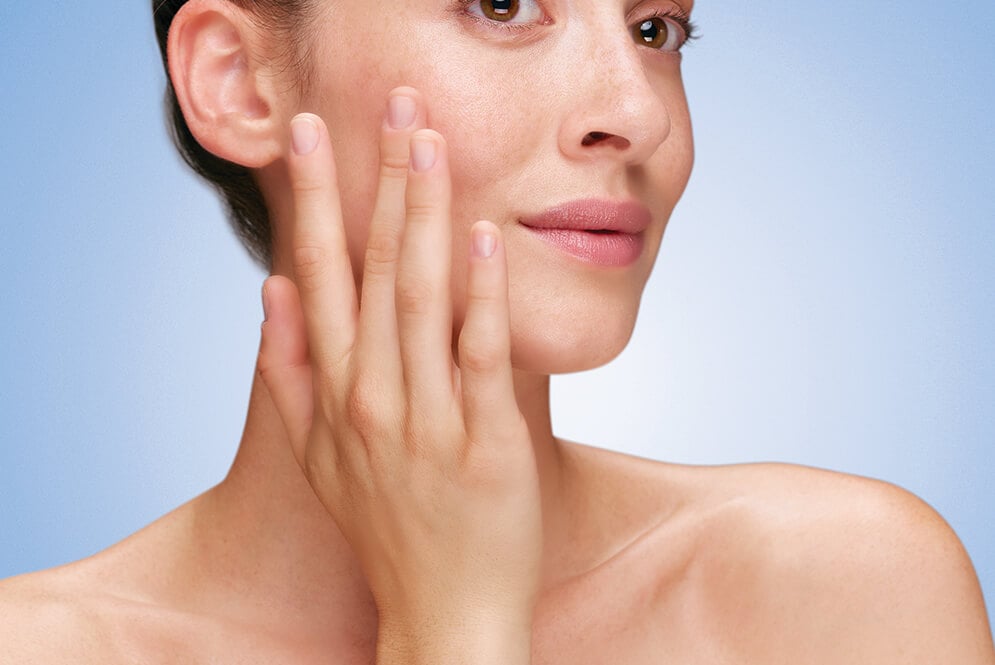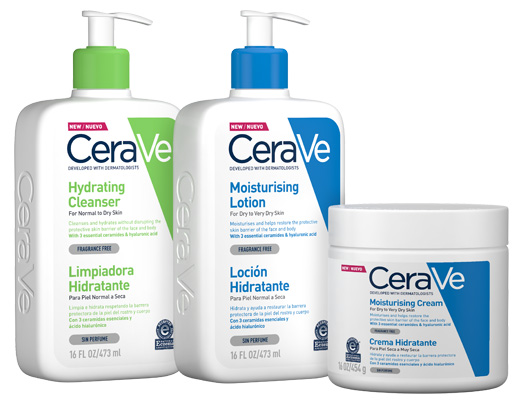Ceramides & Hyaluronic Acid: Their Role in Achieving Beautiful Skin
EVERYDAY SKINCARE
Overview

Ceramides and hyaluronic acid are both naturally occurring substances produced in the body that help the skin retain moisture and support softer, smoother skin. But do these ingredients do the same thing? And what are the benefits of adding them to your routine? This article explores these two key ingredients, their benefits, their differences, and how to add them to your skincare routine.
Key Facts
-
Both naturally occurring substances produced by the body, these two skincare ingredients support skin hydration, but do so in different ways.
-
Ceramides are lipids, which are fatty acids that are produced in the sebaceous glands. The help strengthen the skin's moisture barrier that protects it from environmental aggressors
-
Hyaluronic acid is a humectant that draws in and attracts water in the skin's surface to maintain skin hydration.
-
When used in tandem, these two ingredients provide deep hydration to support healthy-looking skin.
Why are ceramides and hyaluronic acid important?
Lacking in ceramides and hyaluronic acid isn't just a cosmetic problem, it can also have impacts on the skin condition. A lack of skin hydration can lead to a compromised moisture barrier, which can expose the skin to harmful environmental aggressors, which can increase the chances of various skin concerns including hyperpigmentation, itching sensations, breakouts and redness.
What's the difference between ceramides and hyaluronic acid?
Though both are important in keep the skin hydrated, they do so in different ways.
| Skincare Ingredient | What it is | What it does |
| Ceramides | An essential lipid that forms the skin's protective barrier | Prevents trans epidermal water loss |
| Hyaluronic Acid | A humectant that attracts and retains water from hydrated skin | Maintains skin hydration that turns translates to a stronger moisture barrier |
What Do Ceramides Do?

What Does Hyaluronic Acid Do?
Hyaluronic acid (HA) is a humectant that holds large quantities of water in the skin. This area has ability to store several litres of fluid per gram. A high concentration of hyaluronic acid therefore means a high content of water, which makes the skin firm and plump. The role of hyaluronic acid in maintaining hydrated skin also strengthens the skin moisture barrier.
What are the benefits of using ceramides and hyaluronic acid?
So both ingredients are essential to hydrated, healthy-looking skin. But there are many other skin benefits:
-
Fuller, plumper skin: By restoring skin hydration, the skin appears visibly fuller and plumper. Used together, ceramides help to lock in moisture that hyaluronic acid attracts and retains, resulting in enhanced skin hydration and a strengthened skin moisture barrier.
-
Stronger moisture barrier: Hydrated skin converts to a stronger moisture barrier, which keeps the skin protected from harmful environmental aggressors.
-
Reduces fine lines and wrinkles: Ceramides and hyaluronic acid can visibly reduce the appearance of fine lines and wrinkles in addition to prevent premature ageing from environmental aggressors
-
Visibly reduces redness: Both ingredients help comfort the skin, helping to visibly reduce irritation as well as redness, particularly beneficial for sensitive skin.
-
Manages excess oil production: Because hyaluronic acid and ceramides maintain moisture levels in the skin's surface, they reduce the risk of the sebaceous glands overproducing sebum, which leads to skin congestion, clogged pores and increases the chances of breakouts.
-
Essential for all skin types: These two ingredients are naturally occurring, making them suitable and necessary for all skin types. They can be found in a range of skincare products to restore hydration.
What Causes a Lack of Ceramides & Hyaluronic Acid?
There a few factors that affect ceramide and hyaluronic acid concentration levels in skin, some of which are age, skin conditions, and environmental and lifestyle factors.
A lack of ceramides and hyaluronic acid is a consequence of the natural aging process. From the age of 25 the body gradually produces less of both. Studies have found an association between a reduction in ceramides and skin condition such as atopic dry skin and aging skin. The consequence of this natural reduction is drier skin that appears less plump and shows wrinkles. Of course, this process varies by individual.
People with dry skin and conditions such as eczema, rosacea, and even acne have depleted levels of ceramides. This can affect the skin all over the body, which means that a lack of ceramides can manifest itself anywhere - such as dry, itchy skin ;on the legs.
Other reasons for a low concentration of ceramides and hyaluronic acid in the skin are environmental and lifestyle factors. Ambient temperature also has an influence on the fat production of the sebaceous glands; at low temperature they produce less ceramides and the glandular glands contract. That is why many people have more issues with dry skin in winter.
Why Are Ceramides & Hyaluronic Acid Important?
Lacking in ceramides and hyaluronic acid isn't just a cosmetic problem - it can also have skin health impacts. When skin is dry the protective skin moisture barrier is not as intact as it should be, so warding off external aggressors can be affected. Therefore, complaints such as skin irritation, contact dermatitis or even atopic dermatitis occur more quickly. This is why a lack of ceramides and hyaluronic acid should always be addressed.
How Do You Improve Your Ceramide & Hyaluronic Acid Levels?
In order to balance or prevent a lack of ceramides and hyaluronic acid, the following three measures are important:

• A healthy lifestyle
• Dietary supplements
• Nourishing cosmetics
A healthy lifestyle supports the natural regeneration of the skin. This includes drinking plenty of water, avoiding stress and getting enough sleep. Hot showers and internal heating deprive the skin of moisture. In winter, the skin is exposed to a frequent change between warm indoor air and cold outside air. It is therefore not surprising that the skin tends to dry out especially in this season.
Skin care products have a direct effect on the outermost layer of the skin, the epidermis, where they counteract damage caused by missing ceramides and hyaluronic acid. Topical delivery of ceramide emulsions supplies lipid replacement and restores lipid balance to the epidermal barrier. Topically applying hyaluronic acid improves your skin’s natural ability to retain water. The skin is not only able to absorb moisture but retention is better as well. For those affected by dry skin conditions, acne or concerned about the signs of aging, it may be useful to nourish the skin with cleansers, moisturisers, or a serum enriched with ceramides and hyaluronic acid.
Moisturisers & Cleansers with both Ceramides and Hyaluronic Acid
The skin care range offered by CeraVe replenishes skin immediately after the first application. For this purpose, CeraVe products uses contain hyaluronic acid as well as three essential ceramides. These are the so-called ceramides 1, 3 and 6-II, which also occur naturally in the skin and are important for a healthy skin moisture barrier. If they are sufficiently abundant, it is more likely that the skin will keep moisture in and foreign bodies out.
In addition, CeraVe's products use MVE technology to provide long-lasting hydration to the skin. The technology is based on many small globules in which ceramides and hyaluronic acid are stacked on top of each other like the skin of an onion, gradually releasing them over 24 hours.